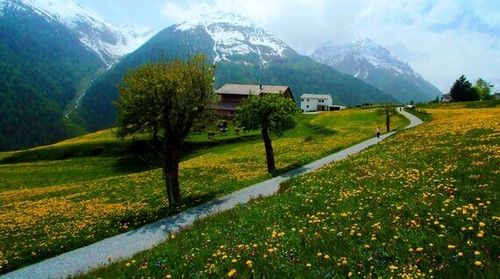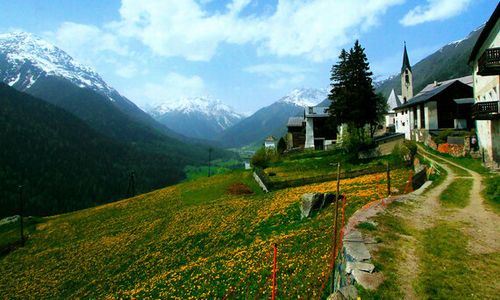

The beautiful deep-cut Engadine valley in Switzerland originates at the foot of the Rhaetian Alps towards the south of the country and extends towards the north-west, up to the Austrian border. The river Inn runs all along the valley and then enters Austria, where it joins the Danube.
While most travelers / tourists visit the famous and glitzy resort town of St. Moritz in this region, the real gems are hidden in the form of quaint little hamlets and villages further up on the mountain terraces and remote valleys; these are places of great interest that are often overlooked.
Tucked away in secluded mountains, these villages are unique because of various reasons. Apart from the fact that majority of the population in these small, isolated villages speaks the archaic Romansch language (close to Latin), these communities have also retained a few vestiges from an old-world culture that are not found in other parts of Switzerland.


For example, in some of these villages, between February and March the old tradition of 'Chalandamarz' is observed - this is a festive day that involves young boys chasing away winter and its 'evil spirits' by going around the streets, clanking large cow bells loudly and singing songs heralding the spring. How charming!
And then there is the annual move of the cows to higher pastures at the onset of summer and their descent in autumn. These events have, over the years, taken the form of lively pastoral festivals. When the cows return to the village in autumn, they are first made to assemble at a pasture outside the village and the 'best cow' (no clue how this is judged though) receives a floral crown - the 'Miss Cow' title if you like. And it doesn't end there. The unfortunate cows that will not make it to the higher pastures the following summer are identified at this time. And you know what this means for those sad cows.
Subsequently, carts are laden with dairy products and taken in a lively procession into the village, accompanied with lusty singing and whip cracking. In the evening there is a dance during which the entire village comes together. Everyone is happy.
The remoteness and relative isolation of these rural communities have largely contributed to preserving their unique culture, old-world architecture and way of life - in fact these villages seem to be locked in a mysterious time warp. And needless to say, this region is also incredibly scenic, almost fairytale like
Guarda is once such village, which we visited during our recent trip to Switzerland. This village is often referred to as the Schellenursli, from a children's story set in this location.
From St. Moritz, which we used as our base during the four days we spent in this region, we went on a scenic train journey towards Guarda, higher up in the mountains, travelling north east, through the magnificent Lower Engadine valley. After we reached Guarda Station, which is a few hundred feet below Guarda Village, we took a small 'Post Bus' further up to Guarda Comun (village) and then explored the village on foot.
Now there couldn't have been a more spectacular setting for this small village of 60+ heritage houses. Located 5,400feet above sea level and over 1,000 feet above the floor of the valley, it is perched high up on a broad sundrenched terrace. The village is closed to traffic, so you don't find any vehicles there, which adds to its old world charm.
The unique feature of this village are the magnificent and well preserved 'sgrafitto' houses, with beautifully painted facades dating back to the first half of the 17th century CE. These old heritage houses, built of stone, lime and wood, have thick coarsely plastered walls washed in white/off white/ light brown, which provide an ideal background for murals executed predominantly in subtle pastel colors and shades.
While 'sgraffito' decorations are sometimes freehand paintings and stencils executed on plaster, more often these are etchings in which the outer coating of plaster, while it is still wet, is consummately scrapped or etched away in beautiful and complex patterns to create splendid murals.
And many houses have interesting messages / aphorisms on the wall, etched in Romansch or Latin, which Peter Hessler, the American author and journalist has interpreted for us.
A wall of a house reads: "We build beautiful houses on earth and know well we won't be living here forever. But we seldom think about the place where we'll be spending eternity." Food for thought indeed!
The houses generally have small and deep windows in the upper floors, wooden or wrought iron hanging balconies, large wooden bay windows and massive arched doors on the ground floor. In spring, balconies overflow with spring flowers.
It was a perfect day for our trip. The mountain weather was sunny and sparkling and we had magnificent views of the snow capped peaks, valleys, the meadows below and the pastures high up.
And as we leisurely walked through the serpentine thoroughfare and cobbled street and alleys, we admired the beautifully restored houses that still preserve wall paintings, enigmatic messages and decorated doors and windows from over 300 years back. We felt we had stepped into the pages of a history book.
And finally on the way out, as we proceeded for our hike in the mountains onto another village, we passed by a house whose 'sgraffito' inscription said "Out of everybody who passes by, who are you?''
Who am I? Indeed a fundamental existential question to occupy my mind for some time, during the course of our hike to the neighboring village of Ardez.
Note: I, along with my wife Nina and our 11-year old daughter, Minnie were in Switzerland last spring for 25 days. For more travel stories and photographs from this amazing trip, you might want to check out http://world-citizen-trail.net/category-travel-and-adventure/